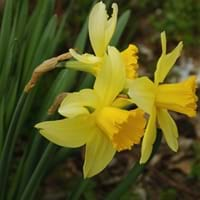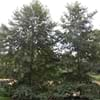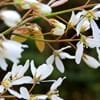Life Span
Perennial
Perennial
Origin
Mid-Atlantic United States, Southeastern United States, Central United States, South-Central United States, Texas
Asia, Central Asia, Eastern Asia, Southwest Europe
Types
Typical Red Buckeye, Yellow-flowered Red Buckeye
Accent, Acropolls, Cassata,Dellbes, Flower parade, Hawera
Habitat
Shady Edge, Woodland Garden Dappled Shade
Hillside, Open scrub, River side, Rocky areas, Scrubs, Woods
USDA Hardiness Zone
5-9
3-9
Sunset Zone
2a, 3a, 3b, 4, 5, 6, 7, 8, 9, 14, 15, 16, 17, 18, 19, 20, 21, 22, 23, 24
A2, A3, 1a, 1b, 2a, 2b, 3a, 3b, 4, 5, 6, 7, 8, 9, 10, 11, 12, 13, 14, 15, 16, 17, 18, 19, 20, 21, 22, 23, 24
Habit
Clump-Forming
Clump-Forming
Flower Color
Yellow, Red, Orange Red
Ivory, Lemon yellow, Peach, White, Yellow, Yellow green
Flower Color Modifier
Bicolor
Bicolor
Fruit Color
Brown
Not Available
Leaf Color in Spring
Dark Green
Green
Leaf Color in Summer
Dark Green
Green
Leaf Color in Fall
Yellow, Dark Green
Green
Leaf Color in Winter
Not Available
Green
Leaf Shape
Elliptic
Linear
Plant Season
Spring, Summer, Fall
All year
Sunlight
Full Sun, Partial Sun, Partial shade
Part sun
Growth Rate
Medium
Medium
Type of Soil
Clay, Loam
Clay, Loamy, Sandy
The pH of Soil
Acidic, Neutral
Acidic
Soil Drainage
Average
Well drained
Bloom Time
Spring
Early Spring, Late Spring, Spring
Tolerances
Not Available
Black Walnut Toxicity
Where to Plant?
Ground
Ground
How to Plant?
Seedlings
From bulbs
Plant Maintenance
Medium
Medium
Watering Requirements
Average Water Needs, Do Not over Water
It cannot sustain wet-feet, Keep the ground moist but not water-logged, Water Deeply, Water when soil is dry
In Summer
Lots of watering
Lots of watering
In Spring
Moderate
Moderate
In Winter
Average Water
Average Water
Soil pH
Acidic, Neutral
Acidic
Soil Type
Clay, Loam
Clay, Loamy, Sandy
Soil Drainage Capacity
Average
Well drained
Sun Exposure
Full Sun, Partial Sun, Partial shade
Part sun
Pruning
Remove dead branches
Cut or pinch the stems, Prune to control growth, Remove dead leaves, Remove dead or diseased plant parts
Fertilizers
Apply 10-10-10 amount
All-Purpose Liquid Fertilizer
Pests and Diseases
Leaf Blotch
Basal rot, Crown rot, Fire, Leaf spot, Scorch, Viruses
Plant Tolerance
Drought
Drought
Flower Petal Number
Single
Single, Double
Foliage Texture
Coarse
Medium
Foliage Sheen
Glossy
Matte
Attracts
Hummingbirds
Not Available
Allergy
Pollen
Asthma, Rhinoconjunctivitis
Aesthetic Uses
Showy Purposes
Showy Purposes
Beauty Benefits
Not Available
Not Available
Environmental Uses
Air purification
Air purification
Medicinal Uses
Cancer, Hypnotic, Odontalgic, Salve
Asthma, Cold, Cough, Vomiting
Part of Plant Used
Seeds
Flowers, Leaves
Other Uses
Grounded seed is used as a gruel, Used as a soap substitute
Showy Purposes
Used As Indoor Plant
No
No
Used As Outdoor Plant
Yes
Yes
Garden Design
Feature Plant, Foundation, Mixed Border, Screening / Wind Break
Not Available
Botanical Name
AESCULUS pavia
Narcissus
Common Name
Red Buckeye
Daffodil
In Hindi
Red Buckeye
हलका पीला
In German
Red Buckeye
Narzisse
In French
Red Buckeye
Jonquille
In Spanish
rojo castaño de Indias
Narciso
In Greek
κόκκινο Buckeye
ασφόδελος
In Portuguese
Red Buckeye
Abrótea
In Polish
Red Buckeye
żonkil
In Latin
Red Buckeye
Asphodelus
Phylum
Magnoliophyta
Magnoliophyta
Class
Magnoliopsida
Liliopsida
Order
Sapindales
Asparagales
Family
Hippocastanaceae
Amaryllidaceae
Clade
Angiosperms, Eudicots, Rosids
Angiosperms, Monocots
Tribe
Not Available
Narcisseae
Subfamily
Hippocastanoideae
Amaryllidoideae
Number of Species
Not Available
Season and Care of Red Buckeye and Daffodil
Season and care of Red Buckeye and Daffodil is important to know. While considering everything about Red Buckeye and Daffodil Care, growing season is an essential factor. Red Buckeye season is Spring, Summer and Fall and Daffodil season is Spring, Summer and Fall. The type of soil for Red Buckeye is Clay, Loam and for Daffodil is Clay, Loamy, Sandy while the PH of soil for Red Buckeye is Acidic, Neutral and for Daffodil is Acidic.
Red Buckeye and Daffodil Physical Information
Red Buckeye and Daffodil physical information is very important for comparison. Red Buckeye height is 370.00 cm and width 300.00 cm whereas Daffodil height is 1.25 cm and width 1.25 cm. The color specification of Red Buckeye and Daffodil are as follows:
Red Buckeye flower color: Yellow, Red and Orange Red
Red Buckeye leaf color: Dark Green
Daffodil flower color: Ivory, Lemon yellow, Peach, White, Yellow and Yellow green
- Daffodil leaf color: Green
Care of Red Buckeye and Daffodil
Care of Red Buckeye and Daffodil include pruning, fertilizers, watering etc. Red Buckeye pruning is done Remove dead branches and Daffodil pruning is done Cut or pinch the stems, Prune to control growth, Remove dead leaves and Remove dead or diseased plant parts. In summer Red Buckeye needs Lots of watering and in winter, it needs Average Water. Whereas, in summer Daffodil needs Lots of watering and in winter, it needs Average Water.





